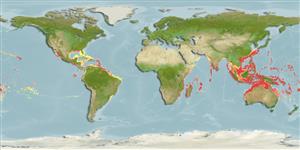Common names from other countries
Environment: milieu / climate zone / depth range / distribution range
Écologie
Pélagique; profondeur 0 - 500 m (Ref. 115106). Subtropical; 30°N - 16°N, 100°W - 78°W
Distribution
Pays | Zones FAO | Écosystèmes | Occurrences | Introductions
Cosmopolitan.
Length at first maturity / Taille / Poids / Âge
Maturity: Lm ? range ? - ? cm Max length : 0.8 cm BL mâle / non sexé; (Ref. 3682)
Maximum depth from Ref. 83943. This is an oceanic epiplanktonic species (Ref. 3702). Particularly found in epipelagic and mesopelagic depths (Ref. 83943). Also neritic (Ref. 116105). Chaetognaths are active carnivores, feeding mostly on copepods, crustacean larvae and other chaetognaths, and occasionally on forams and fish larvae (Ref. 81541).
Life cycle and mating behavior
Maturité | Reproduction | Frai | Œufs | Fécondité | Larves
Members of the phylum Chaetognatha are hermaphroditic. Mating behavior: A preliminary visual signaling behavior for species recognition is observed to prevent predation. Life cycle: Eggs directly develop into miniature adults (hatchlings).
Pierrot-Bultz, A. 2004. (Ref. 3682)
Statut dans la liste rouge de l'IUCN (Ref. 130435)
statut CITES (Ref. 108899)
Not Evaluated
Not Evaluated
Utilisations par l'homme
| FishSource |
Outils
Plus d'informations
Taille/ÂgeCroissanceLongueur-poidsLongueur-longueurMorphologieLarvesAbondance
Sources Internet
Estimates based on models
Preferred temperature
(Ref.
115969): 13.3 - 26.4, mean 19.7 (based on 501 cells).
Vulnérabilité
Low vulnerability (10 of 100).
Catégorie de prix
Unknown.
